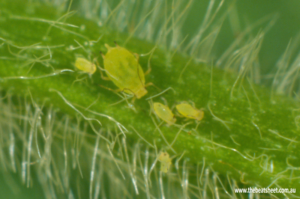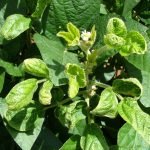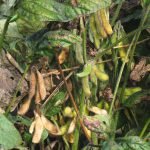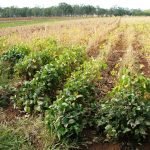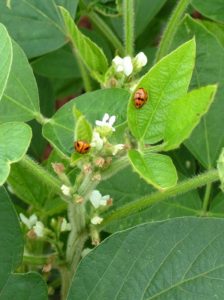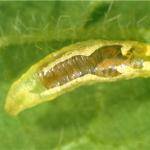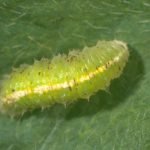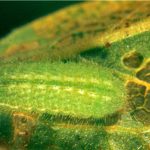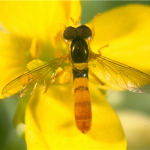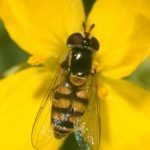Significant soybean aphid (Aphis glycines) populations have now been observed in many coastal soybean crops. Once the crop approaches late flowering, a spray decision must be made as later aphid infestations can severely delay harvest maturity.
Careful monitoring is required to determine if populations are trending upwards to and beyond threshold levels, or if the aphids are being contained by predators. Symptoms of obvious plant damage (leaf distortion or yellowing, stunted plants, sooty mould etc.) may indicate aphid hot-spots. Natural enemies can be sampled with a beat sheet or sweep net; aphids are best sampled visually.
- Distorted and sticky aphid-infested leaves on a heavily infested soybean plant. Note the pale cast-off aphid skins on the older leaf at the top of the picture.
- Large variation in maturity in a crop with severe soybean aphid infestation
- Markedly delayed maturity in unsprayed headland contrasting with harvest ready maturity of the main crop which as sprayed with pirimicarb (under permit) to control a well-above threshold soybean aphid population
Estimate aphids/plant on at least 30 plants throughout the paddock (not just the areas with obvious symptoms). Compare counts across sampling dates to determine population changes (graphs work well for this). The US-based threshold for crops up to full seed (R6) stage is 250 aphids per plant (and increasing), and usually more than 80% of plants with aphids. As a rule of thumb, if you can see aphids on the main stem, you are well over threshold.
A binomial ‘speed scouting’ version (Hodgson et al. 2004) samples plants 30 paces apart, and rates infestation as 40 or more aphids/plant. Starting with a minimum of 11 plants, calculate if the proportion of plants infested is over 85% (treat) or less than 70% (don’t treat; recheck in 7-10 days). If infestation is between these values, continue sampling and recalculate every 5 plants. If infestation is still at 70-85% after 31 plants, resample in 3-4 days.
Many aphid-infested crops also have significant ladybird and hoverfly larvae populations, both of which are key aphid predators. While some species of aphid parasitoids present in Australia may potentially use soybean aphids as hosts, they are rarely (if ever) seen in soybean fields.
The IPM strategy for aphids is to only use soft insecticides against pests during the vegetative stage to foster these and other beneficials. This is also a key resistance-management strategy for helicoverpa and fits in the ‘Go Soft Early’ soybean IPM slogan.
The full Helicoverpa Insecticide Resistance Management Strategy (IRMS), is available at the IPM Guidelines for Grains website.
It’s important when sampling not to confuse hoverfly larvae with grass blue larvae (GBB – a pest) which have also been common in many crops. The two are similar in outline (both are slug-like), but the hoverfly taper towards the head whereas the GBB larvae have a broad rounded head end. Hoverfly larvae also lack legs. A final ID clincher is to place the suspect on your hand. The good guy (hoverfly) will raise their head and wiggle it from side to side looking for aphids (see a video of this behaviour).
- Hoverfly larva with internal organs clearly visible (8 mm)
- A hoverfly species (8 mm) that could easily be mistaken for a grass blue larva
- Grass blue butterfly larva (10 mm)
- Orange-banded slender hoverfly adult (9 mm)
- Common hoverfly adult (9 mm) with bee-like appearance
Above-threshold aphid populations by flowering lead to very uneven plant and pod maturity. This makes harvest extremely difficult, with green plants and pods still present when the crop should be harvest-ready. The softest and preferred aphidicide option is pirimicarb (PER 85152 – valid till 31 July 2019).
Many aphid-infested crops are also infested with GBB and helicoverpa and may require a dual Altacor/pirimicarb spray. Ensure the pirimicarb granules are dissolved and added to the spray tank first, and add the dissolved Altacor granules last. Both are rainfast after 2-3 hours.
When using Altacor (chlorantraniliprole), always add a non-ionic surfactant and apply in at least 100 L of water per ha. In narrow row well canopied crops, preferably lift the spray volume to 200 L/ha to achieve better coverage.
Also check the GRDC nozzle guide to ensure the nozzles on your spray boom are delivering medium droplets. Good coverage is essential for Altacor and other ingestion insecticides (Steward, Affirm and Success Neo), and can only be achieved with nozzles delivering medium droplets, not coarse or very-coarse droplets. Note that coverage problems have been reported in many crops sprayed with air induction nozzles, especially with high pressure air-induction nozzles, which are designed to produce larger droplets for drift control.
The statistical basis of the USA sampling systems described above is found in: Hodgson, E. W et al. (2004) Enumerative and Binomial Sequential Sampling Plans for Soybean Aphid (Homoptera: Aphididae) in Soybean J. Econ. Entomol. 97(6): 2127-2136.
Photographs by Hugh Brier and Joe Wessels.

